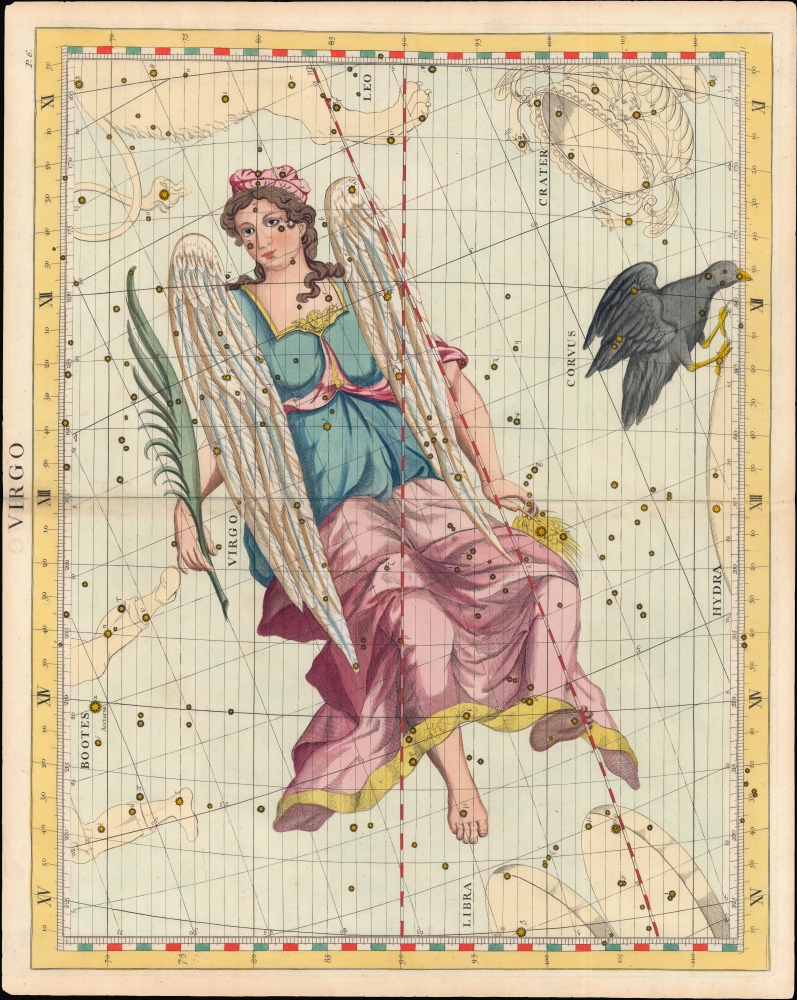This item has been sold, but you can get on the Waitlist to be notified if another example becomes available, or purchase a digital scan.
1729 / 1781 Flamsteed Celestial Chart of the Virgo Constellation
Virgo-flamsteed-1781
Title
1781 (undated) 25.25 x 20.5 in (64.135 x 52.07 cm)
Description
A Closer Look
Stars are depicted to reflect their brightness, with the brighter stars following the Bayer classification system using Greek letters, in which the brightest star of the Virgo constellation (Spica, near the center, below Virgo's left hand) was classified Alpha Virginis, the second brightest as Beta Virginis (near the top of Virgo's left wing), the third brightest as Gamma Virginis (further down her left wing), and so on. In addition to Virgo, portions of the Boötes, Leo, Crater, Corvus, Hydra, and Libra constellations appear.The Most Important Celestial Atlas of the 18th Century
John Flamsteed was the first Astronomer Royal, and as part of his duties, collected new stellar data from the newly-constructed Greenwich Observatory for a star atlas. Flamsteed refused to publish out-of-date data and meticulously updated his celestial atlas throughout his life, racing against the fast-developing world of observational astronomy. Astronomy won, and Flamsteed died in 1719, his works unpublished. His widow Margaret edited the works, publishing Historia Coelestis in 1725 and the Atlas Coelestis in 1729. James Mynde's engravings of the 25 charts were based on the baroque paintings of James Thornhill (1625 - 1734).Publication History and Census
This chart was engraved by James Mynde for the 1729 edition of the Atlas Coelestis. The present example exhibits a plate number, as appeared in the 1753 and 1781 editions of the work. It is printed on woven paper, which cannot have appeared prior to the 1781 edition printed by C. Nourse in London. We are aware of examples of the 1781 edition printed on laid paper, so while we are aware of no further Nourse editions, we cannot discount the possibility that there is an unrecorded later issue. We suspect that Nourse used both laid and woven paper, as per availability and customer demand. The Atlas Coelestis is well represented in institutional collections, although there are only 14 entries for the 1781 edition. The separate chart appears in OCLC among the holdings of the National Library of Australia. Examples are also held by the National Museum of American History (Smithsonian) and the University of Coimbra. This sheet is, therefore, quite rare, especially with such exquisite hand coloring.CartographerS
John Flamsteed (August 19, 1646 - December 31, 1719) was a British astronomer, member of the Royal Society, and was the First Astronomer Royal. He is best known for having compiled his catalog of 3,000 stars, the Catalogus Britannicus, and his star atlas Atlas Coelestis, despite both having been published posthumously. His observations of Uranus were the first to be recorded. He was born the son of a malter, and studied Latin and history until 1662. Prior to his leaving for Cambridge, he studied mathematics and began his interest in astronomy, supplementing his reading of early texts with his own observations and those of fellow enthusiasts. At the age of 19 he would write his first paper on the topic. Having signed up at Cambridge he seems to have spent little time there - soon accepting an invitation to London, where he assisted in assessing proposals for the discovery of the longitude. One result of this was a royal directive to establish an observatory in aid of lunar methods of determining longitude, and in March 1675 Flamsteed was appointed 'The King's Astronomical Observator', the first English Astronomer Royal. He was admitted to the Royal Society in 1676, and lived in the Observatory until 1684. The quality of his calculations was so respected by Isaac Newton and Edmund Halley that they stole and pirated his unreleased observations in 1712. (Their respect of his abilities did not, apparently, extend to their respect for his intellectual property.) He later joined the priesthood and became a village rector, despite retaining his title and duties as Astronomer Royal, until his death. Flamsteed's official version of Historia Coelestis Britannica would not be published until 1725 after his death, edited by his widow, Margaret Flamsteed. In 1729 she published his Atlas Coelestis. More by this mapmaker...
James Mynde (1702 - 1770) was a British engraver. He produced many maps and charts from as early as 1725 and as late as 1768: his work ranged from maps and diagrams to celestial charts (namely, those of John Flamsteed's posthumous celestial atlas.) He was the son of Benjamin and Ann Mynde, who were stationers in Clerkenwell; his father was employed as a bookbinder. In his long career he trained a number of apprentices, including John Gibson. Learn More...

